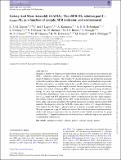Files in this item
Galaxy And Mass Assembly (GAMA) : the sSFR-M* relation part I - σsSFR-M* as a function of sample, SFR indicator, and environment
Item metadata
| dc.contributor.author | Davies, L. J. M. | |
| dc.contributor.author | del P. Lagos, C. | |
| dc.contributor.author | Katsianis, A. | |
| dc.contributor.author | Robotham, A. S. G. | |
| dc.contributor.author | Cortese, L. | |
| dc.contributor.author | Driver, S. P. | |
| dc.contributor.author | Bremer, M. N. | |
| dc.contributor.author | Brown, M. J. I. | |
| dc.contributor.author | Brough, S. | |
| dc.contributor.author | Cluver, M. E. | |
| dc.contributor.author | Grootes, M. W. | |
| dc.contributor.author | Holwerda, B. W. | |
| dc.contributor.author | Owers, M. | |
| dc.contributor.author | Phillipps, S. | |
| dc.date.accessioned | 2019-10-15T16:30:01Z | |
| dc.date.available | 2019-10-15T16:30:01Z | |
| dc.date.issued | 2019-02 | |
| dc.identifier | 261905124 | |
| dc.identifier | 71640a66-f0ad-41c6-9d78-5d955cc59b29 | |
| dc.identifier | 85095241603 | |
| dc.identifier.citation | Davies , L J M , del P. Lagos , C , Katsianis , A , Robotham , A S G , Cortese , L , Driver , S P , Bremer , M N , Brown , M J I , Brough , S , Cluver , M E , Grootes , M W , Holwerda , B W , Owers , M & Phillipps , S 2019 , ' Galaxy And Mass Assembly (GAMA) : the sSFR-M* relation part I - σ sSFR -M* as a function of sample, SFR indicator, and environment ' , Monthly Notices of the Royal Astronomical Society , vol. 483 , no. 2 , pp. 1881–1900 . https://doi.org/10.1093/mnras/sty2957 | en |
| dc.identifier.issn | 0035-8711 | |
| dc.identifier.other | ArXiv: http://arxiv.org/abs/1811.03712v1 | |
| dc.identifier.uri | https://hdl.handle.net/10023/18676 | |
| dc.description.abstract | Recently, a number of studies have proposed that the dispersion along the star formation rate (SFR) – stellar mass relation (σsSFR–M*) – is indicative of variations in star formation history driven by feedback processes. They found a ‘U’-shaped dispersion and attribute the increased scatter at low and high stellar masses to stellar and active galactic nuclei feedback, respectively. However, measuring σsSFR and the shape of the σsSFR–M* relation is problematic and can vary dramatically depending on the sample selected, chosen separation of passive/star-forming systems, and method of deriving SFRs (i.e. H α emission versus spectral energy distribution fitting). As such, any astrophysical conclusions drawn from measurements of σsSFR must consider these dependencies. Here, we use the Galaxy And Mass Assembly survey to explore how σsSFR varies with SFR indicator for a variety of selections for disc-like ‘main-sequence’ star-forming galaxies including colour, SFR, visual morphology, bulge-to-total mass ratio, Sérsic index, and mixture modelling. We find that irrespective of sample selection and/or SFR indicator, the dispersion along the sSFR–M* relation does follow a ‘U’-shaped distribution. This suggests that the shape is physical and not an artefact of sample selection or method. We then compare the σsSFR–M* relation to state-of-the-art hydrodynamical and semi-analytic models and find good agreement with our observed results. Finally, we find that for group satellites this ‘U’-shaped distribution is not observed due to additional high scatter population at intermediate stellar masses. | |
| dc.format.extent | 20 | |
| dc.format.extent | 45245285 | |
| dc.language.iso | eng | |
| dc.relation.ispartof | Monthly Notices of the Royal Astronomical Society | en |
| dc.subject | Galaxies: evolution | en |
| dc.subject | Galaxies: general | en |
| dc.subject | Galaxies: groups: general | en |
| dc.subject | QB Astronomy | en |
| dc.subject | QC Physics | en |
| dc.subject | NDAS | en |
| dc.subject.lcc | QB | en |
| dc.subject.lcc | QC | en |
| dc.title | Galaxy And Mass Assembly (GAMA) : the sSFR-M* relation part I - σsSFR-M* as a function of sample, SFR indicator, and environment | en |
| dc.type | Journal article | en |
| dc.contributor.institution | University of St Andrews. School of Physics and Astronomy | en |
| dc.identifier.doi | 10.1093/mnras/sty2957 | |
| dc.description.status | Peer reviewed | en |
| dc.identifier.url | http://arxiv.org/abs/1811.03712 | en |
This item appears in the following Collection(s)
Items in the St Andrews Research Repository are protected by copyright, with all rights reserved, unless otherwise indicated.

